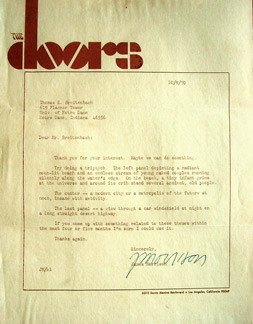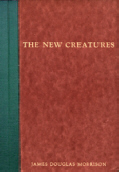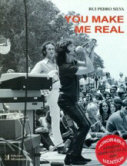
 The first letter sent to the artist by Jim
Morrison of the Doors, suggesting a theme for the painting: The first letter sent to the artist by Jim
Morrison of the Doors, suggesting a theme for the painting:
10/9/70
Dear Mr. Breitenbach,
Thank you for your interest.
Maybe we can do something.
Try doing a triptych. The left
panel depicting a radiant moon-lit beach and an endless stream of young na
ked couples running silently along the water's edge. On the beach,
a tiny infant grins at the universe and around its crib stand several
ancient, old people.
The center -- a modern city or
metropolis of the future at noon, insane with activity.
The last panel -- a view
through a car windshield at night on a long straight desert highway.
If you come up with something
related to these themes within the next four or five months I'm sure I can
use it.
Thanks again.
Sincerely,
James Morrison
You can read all the letters
here. |
THE JIM MORRISON TRIPTYCH
by T.E. Breitenbach
This was a collaboration the artist did with Jim
Morrison of The Doors, before his death in 1971. It was
intended to be used on the "American Prayer" album. Jim
was quite specific about some of the images in the
painting and others were taken from his poetry. Read
Jim's first letter to the artist, and learn more about
this lost project below.
The poster includes a
printout of the first letter and a history of the project.
24 x 36 inches (fits standard frame size)
$24.00
$18.00
Save: 25% off
|
|
 Those
of you who are Jim Morrison fans may be interested in
learning about the painting that T. E. Breitenbach did
with Jim Morrison of the Doors, during the winter of
1970-71.
Those
of you who are Jim Morrison fans may be interested in
learning about the painting that T. E. Breitenbach did
with Jim Morrison of the Doors, during the winter of
1970-71.
In his high school years, Breitenbach
played all of the Doors' tunes in his rock and roll band.
(He played lead guitar and still has his Fender Jaguar
guitar.) He admired the colorful, surrealistic lyrics of Jim
Morrison, and wrote to tell him so, offering at the same
time to paint an album cover. Jim Morrison replied favorably
and sent his ideas for the painting, along with two
autographed, private-editions of his poetry, The
New Creatures and An
American Prayer.
 Breitenbach set to work immediately, painting it in his
college dorm room, and drawing on images from the books for
the center panel. Morrison was pleased with the results and
asked if he could use the painting on the cover of an album
of poetry he was working on. Breitenbach set to work immediately, painting it in his
college dorm room, and drawing on images from the books for
the center panel. Morrison was pleased with the results and
asked if he could use the painting on the cover of an album
of poetry he was working on.
The final contact with Morrison was a note from his
secretary Katherine Lisciandro, indicating that Mr. Morrison
had taken up residence in Paris for a while. He died there,
July 3, 1971 at age 27.
The project Jim Morrison was working on was the An
American Prayer album,
released well after his death. Unfortunately, his intention
to use the painting was not known by the record's producers.
Around 1979, Breitenbach showed the painting to Jann Wenner of Rolling Stone Magazine. Wenner forwarded the
information to Morrison biographer Jerry Hopkins who
explained the meaning of the painting: The left panel
represents a recurring dream that Jim
Morrison had. The center panel reflects his interest in
chaos and madness. The right panel refers to an incident in
his childhood, when he and his father came upon a road
accident in the desert. It was the first time he experienced
fear. This is also referred
 to
in the Doors' song Peace
Frog, "Indians scattered on dawn's highway bleeding." to
in the Doors' song Peace
Frog, "Indians scattered on dawn's highway bleeding."
Breitenbach later turned an idea from Morrison's
poem The Lords into
an illustrated fantasy novel, Grumparar's
the New Creatures: An Adventure and Field Guide
available as an ebook.
The story of this painting, along with full-color photos of
the painting and all the memorabilia was recently published
in Rui Silva's book You Make Me Real and appears in other
Morrison/Doors biographies as well. Mr. Breitenbach will
also appear in a forthcoming documentary about The Doors |

